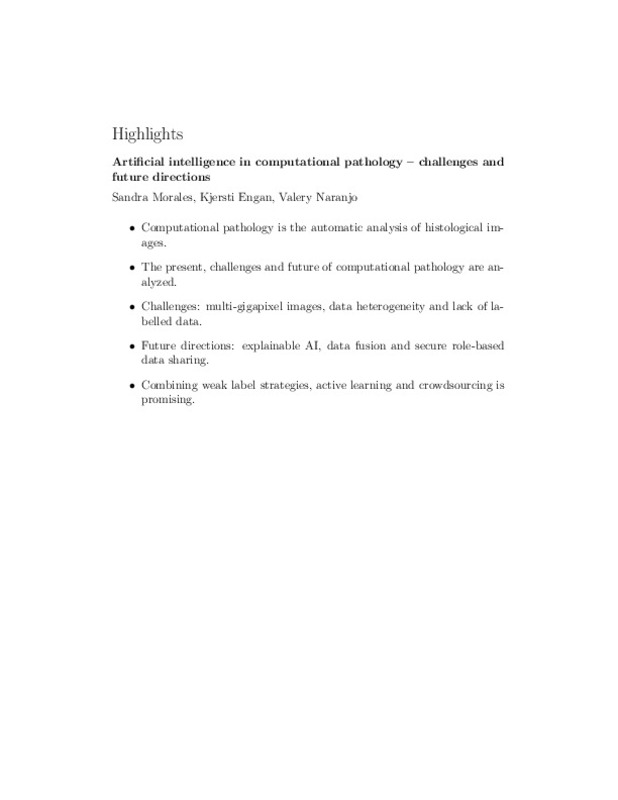JavaScript is disabled for your browser. Some features of this site may not work without it.
Buscar en RiuNet
Listar
Mi cuenta
Estadísticas
Ayuda RiuNet
Admin. UPV
Artificial intelligence in computational pathology - challenges and future directions
Mostrar el registro sencillo del ítem
Ficheros en el ítem
| dc.contributor.author | Morales, Sandra
|
es_ES |
| dc.contributor.author | Engan, Kjersti
|
es_ES |
| dc.contributor.author | Naranjo Ornedo, Valeriana
|
es_ES |
| dc.date.accessioned | 2022-01-17T19:27:05Z | |
| dc.date.available | 2022-01-17T19:27:05Z | |
| dc.date.issued | 2021-12 | es_ES |
| dc.identifier.issn | 1051-2004 | es_ES |
| dc.identifier.uri | http://hdl.handle.net/10251/179755 | |
| dc.description.abstract | [EN] The field of digital histopathology has seen incredible growth in recent years. Digital pathology is becoming a relevant tool in healthcare, industrial and research sectors to reduce the saturation of pathology departments and improve the productivity of pathologists by increasing diagnostic accuracy and reducing turnaround times. Artificial Intelligence (AI) algorithms may be used for the identification of relevant regions, extraction of features from a histological image and overall classification of images into specific classes. The combination of digital histopathology imaging and AI therefore presents a significant opportunity for the support of the pathologists' tasks and opens up a whole new world of computational analysis. In this paper, we have analysed the present, the challenges and the future of the computational pathology discussing the different existing strategies to overcome its main limitations and ensure the computational pathology acceptance. The lack of labelled data, which is the possibly largest challenge for all medical AI applications, is even more pronounced in computational pathology because of the multi-gigapixel nature of the images and high data heterogeneity. We consider the future of the computational pathology is the combination of weak label strategies with active learning and crowdsourcing scenarios since it would remove some of the workload from clinical experts and manual annotation obtaining clinically satisfactory performance with minimal annotation effort. In addition, we believe areas such as explainable AI, data fusion and secure role-based data sharing will be receiving increasing research attention in computational pathology in the close future. | es_ES |
| dc.description.sponsorship | This work has received funding from the European Union's Horizon 2020 research and innovation programme under the Marie Skodowska Curie grant agreement No 860627 (CLARIFY Project) and GVA through project PROMETEO/2019/109. The work of San-dra Morales has been co-funded by the Universitat Politecnica de Valencia through the program PAID-10-20 | es_ES |
| dc.language | Inglés | es_ES |
| dc.publisher | Elsevier | es_ES |
| dc.relation.ispartof | Digital Signal Processing | es_ES |
| dc.rights | Reserva de todos los derechos | es_ES |
| dc.subject | Computational pathology | es_ES |
| dc.subject | Digital pathology | es_ES |
| dc.subject | Deep learning | es_ES |
| dc.subject | Artificial intelligence | es_ES |
| dc.subject.classification | TEORIA DE LA SEÑAL Y COMUNICACIONES | es_ES |
| dc.title | Artificial intelligence in computational pathology - challenges and future directions | es_ES |
| dc.type | Artículo | es_ES |
| dc.identifier.doi | 10.1016/j.dsp.2021.103196 | es_ES |
| dc.relation.projectID | info:eu-repo/grantAgreement/EC/H2020/860627/EU/ | es_ES |
| dc.relation.projectID | info:eu-repo/grantAgreement/GENERALITAT VALENCIANA//PROMETEO%2F2019%2F109//COMUNICACION Y COMPUTACION INTELIGENTES Y SOCIALES/ | es_ES |
| dc.rights.accessRights | Abierto | es_ES |
| dc.contributor.affiliation | Universitat Politècnica de València. Departamento de Comunicaciones - Departament de Comunicacions | es_ES |
| dc.description.bibliographicCitation | Morales, S.; Engan, K.; Naranjo Ornedo, V. (2021). Artificial intelligence in computational pathology - challenges and future directions. Digital Signal Processing. 119:1-11. https://doi.org/10.1016/j.dsp.2021.103196 | es_ES |
| dc.description.accrualMethod | S | es_ES |
| dc.relation.publisherversion | https://doi.org/10.1016/j.dsp.2021.103196 | es_ES |
| dc.description.upvformatpinicio | 1 | es_ES |
| dc.description.upvformatpfin | 11 | es_ES |
| dc.type.version | info:eu-repo/semantics/publishedVersion | es_ES |
| dc.description.volume | 119 | es_ES |
| dc.relation.pasarela | S\450562 | es_ES |
| dc.contributor.funder | GENERALITAT VALENCIANA | es_ES |
| dc.contributor.funder | COMISION DE LAS COMUNIDADES EUROPEA | es_ES |
| dc.contributor.funder | UNIVERSIDAD POLITECNICA DE VALENCIA | es_ES |







![[Cerrado]](/themes/UPV/images/candado.png)

